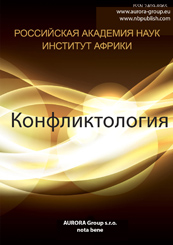Political conflicts in global politics and international relations
Reference:
Panov, D.S. (2025). From Expansion to Restriction: CIA Reforms under the Presidential Administrations of D. Eisenhower and J. Kennedy. Conflict Studies / nota bene, 2, 1–15. https://doi.org/10.7256/2454-0617.2025.2.73723
Abstract:
The object of the study is the functioning of national security agencies in American foreign policy during the administrations of D. Eisenhower and J. Kennedy (1950s – 1963). The subject of the study is changes in the activities and powers of the CIA in connection with the change in political courses of the two presidents. This work allows to understand the driving forces of modern events using the example of the past. The article examines the conflict in the "president-intelligence agencies" system, namely the relationship between the role and place of the CIA during the conservative administration of President D. Eisenhower and the liberal John Kennedy. Particular attention is paid to the Director of Intelligence Allen Dulles, who was one of the most significant figures in American foreign policy. The emphasis in the work is made on the expansion and reduction of powers, organizational reforms, their causes and covert operations that served as a catalyst for long-overdue changes. The study uses the historical-comparative method to analyze the approaches of the Eisenhower and Kennedy administrations, the historical-systemic method to study the role of the CIA in the context of foreign policy, and the analysis of documents (laws, directives, memoirs) to reconstruct events and identify cause-and-effect relationships. The nomothetic method reveals patterns between the work of intelligence agencies and political cycles. The study revealed contradictions in American national security in the mid-20th century, which lay in the "US President - intelligence agencies" system. In the 1950s and 1960s, the US intelligence agencies, especially the CIA, carried out large-scale activities due to the conservative political cycle and extensive powers. Particular attention in the study is paid to the Director of the CIA, who had a noticeable influence on foreign policy. The theoretical novelty of the work lies in the implementation of a synthesis of historical and political science approaches. Historical and archival analysis of primary documents made it possible to reconstruct the institutional mechanisms of the influence of intelligence agencies on the American foreign policy process. The political interpretation of the obtained data through the prism of the cyclical theory of A. Schlesinger Jr. revealed the influence of the change of cycles (conservatism/liberalism) on the dynamics of institutional interaction between the president and intelligence.
Keywords:
liberalism paradigm, realism paradigm, international relations theory, covert operations, CIA, Cold War, Allen Dulles, John Kennedy, Dwight Eisenhower, USA
Economy in conflict studies
Reference:
Molchanova, E.G. (2025). Competition between the trading houses "Churin and Co." and "Kunst and Albers" in the Far Eastern Russia in the late 19th – early 20th centuries. Conflict Studies / nota bene, 2, 16–31. https://doi.org/10.7256/2454-0617.2025.2.74240
Abstract:
The subject of the study is the competition between the two largest trading houses in the Russian Far East - the Russian firm Churin & Co. and the German company Kunst & Albers. The article examines the main forms and methods of competition between these enterprises in the context of the socio-economic development of the region and state policy in the second half of the 19th - early 20th centuries. The history of the creation and development of these companies, the features of their retail networks, and their contribution to the urban life of Vladivostok, Khabarovsk, and other centers of the region are analyzed. The work includes an analysis of business strategies, interactions with authorities, adaptation to political changes (including the anti-German campaign during the First World War), as well as the influence of the rivalry between the trading houses Churin & Co. and Kunst & Albers on the development of the Far Eastern region of the Russian Empire. The methodology is based on the problem-chronological and comparative-historical approaches, with the involvement of archival materials (documents of the Ministry of Trade and Industry, the office of the Primorsky Governor-General), reports of government inspectors, the press and business correspondence. The scientific novelty of the work lies both in the formulation of the problem and in the comprehensive study of the transformation of economic competition into an instrument of political struggle, as well as in identifying the mechanisms of interaction between business and the state in the conditions of a peripheral region. The main conclusions of the study can be formulated as follows. The competition between the firms "Churin and Co" and "Kunst and Albers", combining market methods and political lobbying, became one of the main drivers of the region's development, contributing to the development of infrastructure, logistics and consumer culture. State policy (free port regime, government orders) determined the success of the companies. During periods of crisis, such as World War I, competition took on a destructive character: economic rivalry was replaced by ideological struggle, including slander campaigns and blackmail, which reflected the subordination of business to the political situation. The study confirms the thesis about the interdependence of economic and political factors in the development of peripheral regions of the empire, where business strategies were formed within the framework of a dialogue with state priorities.
Keywords:
government contracts, anti-German campaign, Blagoveshchensk, Vladivostok, Far East, Priamurye, Primorye, competition, Kunst and Albers, Churin and Co
Psychological consulting
Reference:
Livak, N.S., Eremeeva, S.V. (2025). Problems of psychological prevention and correction of emotional burnout in the system of the Ministry of Emergency Situations. Conflict Studies / nota bene, 2, 32–50. https://doi.org/10.7256/2454-0617.2025.2.74341
Abstract:
The article addresses the current issue of emotional burnout among employees of the Ministry of Emergency Situations of Russia, caused by the constant impact of extreme factors, a high degree of responsibility, and professional risks. For employees of the Ministry of Emergency Situations, this issue becomes especially significant, as their work involves the constant necessity to make quick decisions in situations that threaten the lives and health of people. Employees play a key role in ensuring public safety and managing the consequences of emergencies. The effectiveness of their work largely depends on their psychological state. The results of the study on emotional burnout among employees contribute not only to optimizing their working environment but also to strengthening public trust in emergency response services. The development of scientifically grounded approaches to the prevention and correction of emotional burnout among employees can be an important contribution to the advancement of labor psychology and extreme psychology. The article describes the features of psychopreventive and psychocorrective work conducted within the Ministry of Emergency Situations, including monitoring psychological states, group prevention, short-term recovery programs, and comprehensive corrective measures. An analysis of the existing programs has been conducted, presenting their strengths and weaknesses, which allowed for the development of recommendations for their improvement.
Keywords:
EMERCOM employees, disaster response, EMERCOM system, stress, psychophysiological testing, professional health, psychocorrection, psychological prevention, emotional burnout, monitoring of psychological state
Ideological confrontation and the war of meanings
Reference:
Liu, Y. (2025). The ideological foundation of the Sino-Russian strategic partnership: from anti-fascism to a shared destiny. Conflict Studies / nota bene, 2, 51–66. https://doi.org/10.7256/2454-0617.2025.2.74428
Abstract:
The article examines the ideological evolution of the Chinese-Russian strategic partnership in the context of the 80th anniversary of the victory over fascism, revealing the dialectic of historical memory and modern values. The purpose of the work is to identify how the anti-fascist narrative is transformed into an ideological basis for the formation of the concept of a “community of common destiny” amid the crisis of the liberal world order. Based on the methodology of Marxist historical materialism, the continuity of the transition from anti-fascist solidarity to the concept of a “community of common destiny” is analyzed through the integration of Qin Yaqing’s theory of “relations” and the concept of “Greater Eurasia” developed by Russian researchers. The article presents a comparative analysis of K. Mannheim’s ideological constructs, revealing the transformation of the anti-fascist narrative into an instrument for legitimizing strategic interaction that overcomes class limitations. The study demonstrates that the synthesis of historical justice and multilateral cooperation forms an alternative model of global governance based on the principles of equality and the rejection of hegemony. This work contributes to the decolonization of theories of international relations. The author uses an interdisciplinary approach: 1) historical and comparative analysis of archival documents and declarations; 2) critical discourse analysis of media texts and speeches by leaders; 3) theoretical reflection within the framework of Marxist dialectics and K. Mannheim's sociology of knowledge, revealing the connection between ideology and interests. The scientific novelty of the study lies in the development of an interdisciplinary analytical model, in which Marxist philosophy (including the dialectic of historical materialism and criticism of imperialist exploitation) is synthesized with modern theories of Sino-Russian relations. Using the example of the evolution from the anti-fascist class solidarity of the 1940s to the concept of a “community of common destiny,” it is demonstrated that proletarian internationalism is transformed into a hybrid paradigm that combines national-state pragmatism with Eurasian civilizational complementarity. Through the prism of the Marxist theory of class struggle, the unique logic of anti-hegemonic resistance is revealed: from military-political symbiosis against Nazism to institutional creation (SCO, BRICS) as a means of denying the "dictatorship of force" under conditions of digital capitalism. It is established that the synthesis of two traditions—Marxist critique of the alienation of labor and Chinese-Russian concepts of relational justice—forms a new epistemology of global governance, where historical legitimation through anti-fascist rhetoric is rethought as a tool for decolonizing international relations, and collective security is materialized through technological sovereignty and network alliances.
Keywords:
multipolarity, international security, global governance, ideology, community of shared destiny, anti-fascist spirit, partnership, Russia, strategic cooperation, China
Domestic political conflicts
Reference:
Ionov, D.D. (2025). The specifics of the left-wing political spectrum in post-Soviet Russia. Conflict Studies / nota bene, 2, 67–79. https://doi.org/10.7256/2454-0617.2025.2.74086
Abstract:
The relevance of studying the left political spectrum in post-Soviet Russia is determined by its role in shaping the ideological field of the country, where there is a demand for social justice, but conservative-statist trends dominate. The post-Soviet period has been marked by a deep transformation of leftist ideas, their adaptation to new challenges, and the search for identity in the conditions of an ideological vacuum. The subject of the research is the left political spectrum of Russia, while the focus is on its specific features formed under the influence of the Soviet legacy, hybridization of ideologies, and the institutional constraints of the political system. The article analyzes key transformations of leftist movements since 1991, with special attention given to their adaptation to the political system, ideological syncretism, and mechanisms of marginalization of radical groups. These processes are viewed as part of intra-political conflicts, where the left spectrum balances between opposition and integration into the system. The study is based on a synthesis of comparative-historical analysis of the programs of political parties and organizations, an institutional approach to the study of the legal framework, and discourse analysis of media publications revealing ideological eclecticism. The methods allowed for the identification of the relationship between ideological transformations of the left spectrum and changes in the political system and socio-economic context. The scientific novelty of the article lies in the systematization of the specifics of the post-Soviet left spectrum through the prism of three key contradictions: between the Soviet legacy and capitalist reality, statism and emancipation, and global trends and regional specificity. It has been established that the left spectrum in Russia is not a successor to the Soviet model or a result of global leftist trends, but represents a hybrid phenomenon, where the ability of leftist organizations to adapt to the dominant political context becomes a matter of survival. The author’s contribution lies in demonstrating how ideologies transform under the pressures of historical, institutional, and cultural constraints, creating unique forms that cannot be reduced to universal schemas. The conclusions of the article may be used to forecast the development of leftist ideologies in the context of increasing state control and social polarization.
Keywords:
anarchism, communism, socialism, social democracy, political ideology, political radicalism, political identity, Left-wing political spectrum, political parties, anti-fascism
 This work is licensed under a Creative Commons Attribution-NonCommercial 4.0 International License.
This work is licensed under a Creative Commons Attribution-NonCommercial 4.0 International License.










 © 1998 – 2025 Nota Bene. Publishing Technologies. NB-Media Ltd.
© 1998 – 2025 Nota Bene. Publishing Technologies. NB-Media Ltd.




